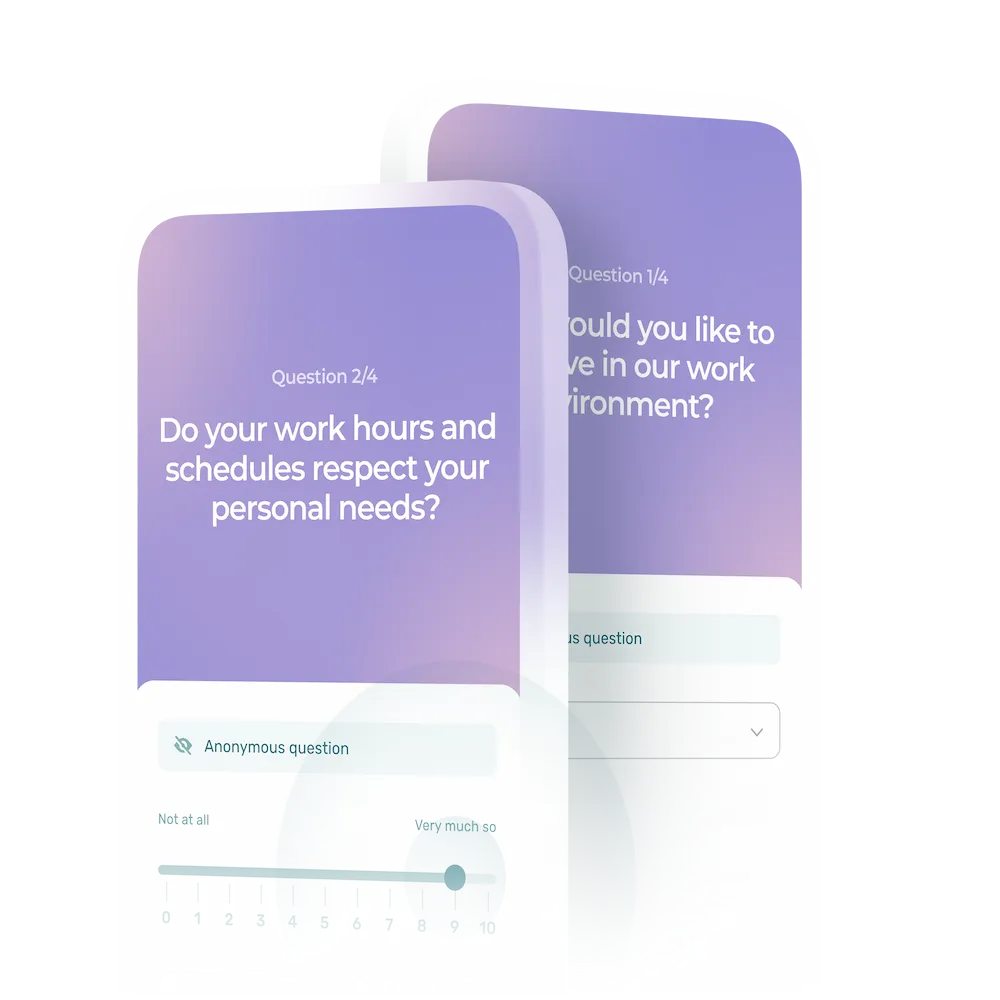The best way to improve employee retention is to promote the well-being of your employees. One excellent way to do so is to measure workplace well-being with pulse surveys.
Although there are many things you can do in the hopes of enhancing your employees’ well-being at work, it’s always a good idea to check in with them so you can make sure that your efforts align with what they really want.
Imagine working hard on multiple initiatives only to miss the mark because you failed to talk them over with the people concerned…🤯
The most common reasons for employee departures include a lack of support or feedback, poor job fit, insufficient opportunity for professional development and advancement, scarce recognition, and overwhelm. In this context, stress tends to rise, further compounding the situation.
All these issues share one thing in common, which is that a manager who is aware of them can make proactive changes to diminish or even eliminate the problem. But to do so, the manager first needs to be aware of what is going on. And this is where a pulse survey can come in handy.
This blog post:
- Explains what a pulse survey is and how it can help you
- Introduces the steps involved in a pulse survey
- Suggests the top 5 surveys you can use to measure well-being at work
What Is a Pulse Survey?
A pulse survey is a brief questionnaire designed to quickly take the pulse of your team. It can measure a variety of metrics. Generally speaking, this type of questionnaire contains multiple-choice questions or questions to answer along a sliding scale (for example, dissatisfied on the left and very satisfied on the right), but it can also contain one or more long-answer questions. Pulse surveys can be anonymous or nominal, mandatory or optional.
To evaluate metrics such as your team members’ well-being, and to achieve 100% representative results and authentic answers, we always recommend that surveys be completed anonymously.
The Advantages of a Pulse Survey
Because they’re easy to complete and can be sent on a recurring basis, pulse surveys are a goldmine for managers. They also offer several advantages for employees.
- They enable managers to quickly adapt their practices according to the answers they receive.
- They give employees a voice and a regular opportunity to express their views on various aspects of their employee experience.
- They can significantly impact staff retention.
- They help identify employees who may be more likely to feel overworked, stressed or at risk of burnout. Although these surveys are anonymous, the manager can see which team the answers come from and address any perceived issues.
How Do You Conduct a Pulse Survey to Measure Well-Being at Work?
1. Set an Objective
Some companies may be tempted to hold a survey “just because,” since it’s a commonplace HR management practice. However, without a clear, genuine objective, it can be a waste of time. A generic survey with overly broad questions will tend to yield nothing more than a surface-level portrait and won’t help you much.
💡 This being said, a more general survey with questions that relate to different themes can be a good starting point and help pinpoint where you feel you need to go deeper.
The survey objective is the starting point and determines the next steps in the process. The objective also determines the questions to ask, as well as who to target with the survey and what to do with the results.
How Do You Determine the Objective for Your Survey?
Would you like to find out your team’s opinion following a change in management methods in recent months? Want to take the pulse of your employees to find out whether a transition is going well, and what impact it is having?
If you’ve followed me this far, you’ve probably guessed by now that the objective should help you find out how your employees feel about a given subject or situation.
Some Examples of Survey Objectives:
- Measure your employees’ satisfaction with their working conditions.
- Measure your employees’ satisfaction with their schedules.
- Measure your employees’ satisfaction regarding their relationship with their immediate manager.
- Assess your team’s level of commitment and loyalty to your company.
- Find out whether your employees would recommend your company to a friend looking for a job.
2. Identify the Survey Target
The target of the pulse survey must be consistent with your objective and with the issue that prompted you to survey the team.
Sometimes all the employees at an organization will be concerned, and other times it might be a single department or employees that hold a same position. For example, at a restaurant, a manager may only want to survey the kitchen staff.
Have you recently lost several members of the same department, and would you like to know the reasons behind their departures? In this case, the best option would be to send your survey only to employees in the department concerned.
3. Opt for an Anonymous Survey
The purpose of an anonymous survey is to gather more authentic answers, so you can make better decisions and take better action. This being said, a non-anonymous open survey has the advantage of letting you follow up with the respondents.
If the subject of the survey is sensitive, and you think your employees would be honest if they had to answer in person, you can opt for an open survey.
💡 A good question to ask yourself is, if you were asked these questions, knowing that your name would be associated with the answers, would you answer openly and truthfully?
When Should You Conduct an Open Survey?
If you want to follow up with your survey respondents, you’ll need to know who answered what. With this in mind, you can explain in the introduction that the survey is open-ended and that answers will be followed up.
4. Create the Survey Questions
The questions are the heart of the survey. There are different types of questions: yes/no, multiple choice, scale from 0 to 10, and (short- or long-answer) open-ended questions.
A Few Quick Tips to Help Formulate Optimal Questions:
- Keep questions short.
- Be clear and precise.
- Prioritize closed-ended, yes/no, 0-10 scale, and multiple choice questions.
- Include a minimum of open-ended questions: questions that can be answered with a personal comment, opinion questions, impressions, etc.
- Keep questions neutral. Neutral questions are unbiased questions. An example of a biased question would be,
o What do you think about your excellent working conditions? 😛 - Keep the survey short (10 questions maximum) to avoid discouraging respondents and to maximize response rates.
Use a Survey Template
In certain apps, such as the Agendrix app, you will find many templates you can use. This way you can simply send a survey that has already been designed and put together for you.
5. Analyze Answers and Make Adjustments
After you send the survey comes a very important part of any pulse survey production process. Sending surveys to your team members to measure their well-being at work is an honorable initiative. However, if the survey results don’t lead to action, you risk breaking your bond of trust with your employees, as well as wasting your team’s time.
When you receive the results of a survey (see example below), you’re presented with a status report. In light of this overall picture, your responsibility is to demonstrate to your employees that you value their opinion, and that you won’t settle for the status quo.
To do this, you can:
- Follow up if your survey was not anonymous: reach out to the employee(s) who mentioned dissatisfaction or answers that would be worth following up on.
- Draw up a game plan to address any dissatisfaction or aspects identified as problematic. For example, imagine that, in your workplace satisfaction survey, 70% of employees said they’d like a cleaner staff room. Be sure to send out a general message explaining that you are aware of this dissatisfaction, and then lay out what you plan to do to resolve the situation.
- Send out a survey shortly thereafter to help clarify anything unclear or requiring further investigation.
5 Examples of Pulse Surveys
Here are 5 examples of ready-made surveys that will enable you to measure the overall well-being of your organization’s employees. The topics of these 5 surveys are:
- Job satisfaction
- Sense of belonging.
- Relationship with the manager.
- Satisfaction regarding relationships with co-workers.
- Satisfaction with recognition received at work.
1. Job Satisfaction
This survey is designed to assess your level of job satisfaction. 🫶
8 questions
1. When you get ready for work in the morning, what are the things that make you most eager to start your day?
Long answer
2. I’ve thought about leaving the organization within the past 3 months.
Scale from 0 to 10
0 = Never
10 = Very often
3. If you could change any aspect of your work, team or organization, what would it be?
Long answer
4. I would recommend the organization to a friend, as an employer of choice.
Answer choices
Yes, without hesitation
Maybe
Never
Don’t know
5. How can we improve your employee experience?
Long answer
6. When I get up in the morning, I can’t wait to go to work.
Scale from 0 to 10
0 = Never
10 = Always
7. What advice can you give us to improve as a team and as an organization?
Long answer
8. Finally, what do you like best about working with us? 😊
Long answer
2. Sense of Belonging
The purpose of this survey is to assess your sense of belonging to the organization and the team. 🔥
9 questions
1. Are you proud to say you work for our organization?
Scale from 0 to 10
0 = Not at all
10 = Absolutely
2. What makes you proud to work with us?
Long answer
3. I’m very familiar with the organization’s mission and values.
Answer choices
Yes
Somewhat
No
4. I feel I am able to find fulfilment and realize my ambitions at work.
Scale from 0 to 10
0 = Not at all
10 = Absolutely
5. If I were offered the same salary and working conditions, I’d consider changing organizations.
Answer choices
Yes
No
Don’t know
6. I feel that my role is useful at the organization.
Answer choices
Yes
Somewhat
No
7. What impact do you think your work has on the organization?
Long answer
8. I share the values of the organization I work for.
Scale from 0 to 10
0 = Completely disagree
10 = Completely agree
9. How likely would you be to recommend the organization to someone you know?
Scale from 0 to 10
0 = Not at all likely
10 = Very likely
3. Relationship With the Manager
The purpose of this survey is to assess your satisfaction regarding your professional relationship with your immediate superior. 👬
7 questions
1. I consider that I have a good relationship with my immediate supervisor.
Answer choices
Yes
No
Don’t know
2. What has the greatest impact on your satisfaction regarding your relationship with your immediate supervisor?
Long answer
3. I think I’m important to my immediate supervisor.
Answer choices
Yes
No
Don’t know
4. Having a satisfying relationship with my immediate supervisor is important to me.
Scale from 0 to 10
0 = Not at all
10 = Absolutely
5. Do you think your immediate supervisor values their relationships with their team members?
Answer choices
Yes
No
Don’t know
6. How satisfied are you regarding your professional relationship with your immediate supervisor?
Scale from 0 to 10
0 = Very poor
10 = Very good
7. If you could change any aspect of your relationship with your immediate superior, what would it be?
Long answer
4. Satisfaction Regarding Relationships With Colleagues
The purpose of this survey is to assess your satisfaction regarding your professional relationships with colleagues at work. 👬
11 questions
1. How satisfied are you regarding your relationships with your colleagues?
Scale from 0 to 10
0 = Not satisfied
10 = Very satisfied
2. I have one or more friends among my work colleagues.
Answer choices
Yes
No
3. What influences your satisfaction with your work relationships?
Long answer
4. I consider myself fortunate to have such good relationships with my colleagues.
Scale from 0 to 10
0 = Not at all
10 = Absolutely
5. Have you had any conflicts with colleagues in the past month?
Answer choices
Yes
No
6. Would you say that your immediate supervisor has an impact on your relationships with colleagues?
Answer choices
Yes
No
Don’t know
7. It’s important for me to have good relationships with my colleagues.
Scale from 0 to 10
0 = Completely unimportant
10 = Very important
8. How does your immediate supervisor affect relationships between colleagues?
Long answer
9. Are your relationships with your colleagues good, even in stressful times?
Scale from 0 to 10
0 = Not at all
10 = Absolutely
10. What could we do to better foster relationships between colleagues?
Long answer
11. Would you recommend that someone join your work team?
Answer choices
Yes, without hesitation
Maybe
Never
Don’t know
5. Satisfaction in Regards to Recognition at Work
The purpose of this survey is to assess your satisfaction with the recognition you receive at work. 💟
7 questions
1. Are you satisfied with how often you receive recognition from your immediate manager?
Scale from 0 to 10
0 = Not at all
10 = Absolutely
2. Ideally, how often would you like to receive recognition from your immediate manager?
Long answer
3. Would you say that recognition is given in a timely way at your organization?
Scale from 0 to 10
0 = Never
10 = Always
4. I get enough recognition from my colleagues at work.
Answer choices
Yes
Not quite
No
Don’t know
5. Is there an easy way to show appreciation to others in your workplace, like an app or a tradition at meetings? If so, what might it be?
Long answer
6. Are you satisfied with the way your immediate manager gives you recognition?
Scale from 0 to 10
0 = Not at all
10 = Absolutely
7. How would you improve the recognition you receive at work to make it more satisfying?
Long answer
Involve Your Team in Decisions That Concern Them
Employee retention is dependent upon employees’ well-being at work. Involving your employees in decision-making about their working conditions or situations can go a long way to nurturing employee engagement. Don’t make the mistake of implementing initiatives without checking whether they really meet your team’s needs. Speak with them, earn their trust, and show them that their opinion matters.














